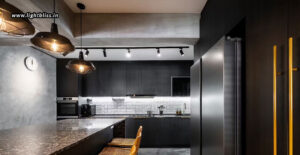Lighting is more than just a utilitarian component in architectural design; it is an expressive artistic tool that may change an environment, evoke feelings, and improve a building’s visual effect. Designers now have more creative freedom because of the LED technology, which allows them to play around with colour, layering schemes, and dynamic lighting effects. This piece explores the creative process of designing architectural LED lighting, emphasizing the cutting-edge methods that are employed to transform spaces into visually stunning ones.
The role of colour theory in LED lighting design
Colour is a major factor in creating a space’s atmosphere. Variations in colour can affect behaviour, elicit feelings, and change perceptions. Designers can employ the wide colour palette that LED lighting offers to create a variety of moods, from cold and energizing to warm and cozy. The capacity of LED lighting to modify colour temperature enables designers to change the atmosphere of a room. For instance, to create a feeling of coziness, warmer colours are frequently employed in homes, while modern businesses or galleries may opt for colder colours.
Adding depth and dimension with light layering techniques
Layering allows you to define spaces, add depth, and establish focus points within a room or building by utilizing several forms of lighting. It is an essential method for creating intricate, visually stimulating surroundings.
- Ambient lighting: Providing general light across the room, ambient lighting is the foundational layer of illumination. Ambient LED lighting is frequently incorporated into walls or ceilings in architectural design to provide a subtle, indirect glow that prepares the space for further lighting levels.
- Task lighting: Designed specifically for activities like reading or working, task lighting delivers focused light. LED lighting fixtures, such as track lights or pendant lights, provide the control and flexibility needed to highlight specific portions of the room without overpowering it.
- Accent lighting: Accent lighting draws attention to decorative elements, artwork, or architectural details. For this, LED strips and spotlights are frequently used because they may be placed subtly to highlight important design components.
Creating a mood with dynamic lighting effects
A room can seem more alive and dynamic with the addition of dynamic lighting effects like timed sequences, colour changes, and intensity shifts. These effects might intensify important occasions and festivities, provoke certain feelings, or create a sense of time passing. Thanks to developments in LED technology, smart lighting systems can now be integrated and users can adjust the colour, intensity, and pattern of the light using automation and apps. Customized experiences are made possible by this improvement in the way light and space interact. Furthermore, designers can add creative aspects to places by casting patterns, textures, or even images onto walls or floors using projected lighting and gobos, which are templates that determine the shape of projected light. LED projectors are increasingly common for use in theatres, public installations, and event spaces today.
Integrating LED lighting into architectural features
The distinction between structure and light is blurred by the smooth integration of LED lighting into architectural elements. LED strips can be integrated into walls, ceilings, stairwells, and even furniture to create luminous, flowing spaces that look both modern and organic. While external LED installations concentrate on making a statement from a distance, interiors can benefit from subtle, integrated illumination. While landscape lighting employs LED to illuminate paths, trees, and water features, facade lighting can completely change a building’s nighttime appearance. Because of its extended lifespan and energy efficiency, LED lighting is a sustainable option for both indoor and outdoor applications.
Architectural LED lighting is more than just lighting; it’s an artistic instrument that helps define a space’s identity. By manipulating colour, layering, and dynamic effects, designers are able to create immersive environments that improve user experience and elicit strong emotions. There are countless opportunities for innovation and sustainability in lighting design as LED technology develops. The way we build and engage with environments is changing as a result of LED lighting’s ability to fuse art and functionality, whether it is used to highlight a museum exhibit, brighten a public plaza, or create atmosphere in a hotel lobby. Architectural lights can thus transform any space, may it be an opulent approach to urban elegance, illuminating modernism and architectural heritage, or personalizing urban interiors. Light Bliss provides a large selection of architectural LED lights, from chandeliers to wall lights, guaranteeing quality and modern design. Hence, Light Bliss is the ideal place to buy architectural lights in Ahmedabadfor individuals who want to enhance their environments with creative lighting options.










